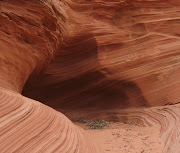 A few weeks from now during the Martian Spring, the Phoenix Mars Lander will bump to a jet pack stop in a choking cloud of Martian dust, park, then remain on alert looking for wild skyscraper tall tornadoes in the immediate area. At least two vortices 100 kilometers across made appearances in the landing zone taken by the unblinking eye of the Mars Orbiter Color Imager. As the frost "melts", floating dust on a still yet war day (sol) morphs into tornadoes reaching massive heights because of low gravity.
A few weeks from now during the Martian Spring, the Phoenix Mars Lander will bump to a jet pack stop in a choking cloud of Martian dust, park, then remain on alert looking for wild skyscraper tall tornadoes in the immediate area. At least two vortices 100 kilometers across made appearances in the landing zone taken by the unblinking eye of the Mars Orbiter Color Imager. As the frost "melts", floating dust on a still yet war day (sol) morphs into tornadoes reaching massive heights because of low gravity. Every precaution to protect the Lander from pernicious North Pole Dust Devils is being undertaken by NASA with three Mars satellites beaming back current Martian weather conditions. However, gentler frigid breezes are welcome in clearing travel grime off the solar panels before unfurling and engaging in the 90 day primary mission of searching for more of the red planet's microbial life, ice water availability and gasp, the effects of climate change.
Every precaution to protect the Lander from pernicious North Pole Dust Devils is being undertaken by NASA with three Mars satellites beaming back current Martian weather conditions. However, gentler frigid breezes are welcome in clearing travel grime off the solar panels before unfurling and engaging in the 90 day primary mission of searching for more of the red planet's microbial life, ice water availability and gasp, the effects of climate change.A Martian CO2 thaw isn't like a spring thaw on Earth: When carbon dioxide frost fades away, it sublimates directly into a gas and goes into the atmosphere.
The warming atmosphere fuels the formation of dust devils. As
explained in this advisory from Malin Space Science Systems, the frequency of dust devils is expected to increase as the thaw proceeds. The full Context Camera strip, which takes in an area 18.6 miles wide and 195 miles long (30 by 314 kilometers) reveals plenty of dark streaks left behind by previous wind action.
Mars' atmosphere is only 1 percent as dense as Earth's, so it's a matter of some interest among planetary scientists to find out how the wind can play such an active role on the Red Planet. Image Credit: NASA/JPL-Caltech/MSSS
 Pictures from the Context Camera affixed to the MRO led to final course corrections before the banner day May 25th landing in a ice water/crystal region. The plan is a live two hour televised Discovery Channel event of the robotic spacecraft's first moments on Mars starting at 7pm EST.
Pictures from the Context Camera affixed to the MRO led to final course corrections before the banner day May 25th landing in a ice water/crystal region. The plan is a live two hour televised Discovery Channel event of the robotic spacecraft's first moments on Mars starting at 7pm EST.The two-hour special will include live footage as the Phoenix Rover arrives on the planet's surface at 7:46pm ET. The craft will be the first to explore the Martian arctic, and the Phoenix team hopes to uncover clues in the icy soil about the history of near-surface ice and its potential for habitability.Even after a couple of spectacular expensive failures and an intense
 competition amongst other august institutions, NASA awarded $325 million dollar research grant to the University of Arizona to develop a lower cost high tech space detective. Based on the canceled hideously expensive Mars Surveyor Lander from 2001, the skeleton was pulled out of NASA's version of earthbound galactic mothballs, retrofitted to fit new (much cheaper) mission parameters and a host of other prestigious universities and defense contractors made common cause to get the Phoenix to rise from the ashes of prior Mars missions.
competition amongst other august institutions, NASA awarded $325 million dollar research grant to the University of Arizona to develop a lower cost high tech space detective. Based on the canceled hideously expensive Mars Surveyor Lander from 2001, the skeleton was pulled out of NASA's version of earthbound galactic mothballs, retrofitted to fit new (much cheaper) mission parameters and a host of other prestigious universities and defense contractors made common cause to get the Phoenix to rise from the ashes of prior Mars missions.Phoenix the project named after the species of Dumbledores's bird, the city of the university location and the capital is a joint scouting mission. Each organization has an element of the project they are responsible for operating. UA's scientific payload responsibility is the operation of the scientific instruments and like most things space these days, there is a robotic arm.

Narrated by Paul Newman and Mars Rover Project King Steven Squyres is Roving Mars, an IMAX production documenting the launch of the long lived rovers, Spirit & Opportunity. It is time well spent looking at the attention to detail and pressures accompanying getting successful launches to explore Mars, the next frontier.










No comments:
Post a Comment